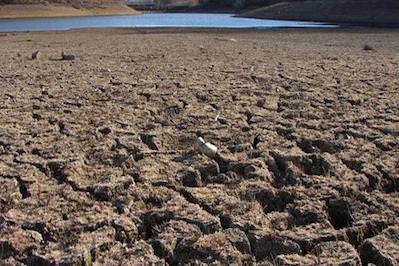Americans Will Face ‘Megadroughts’ and Superstorms
New studies warn that such dangerous weather events could occur regularly in the U.S. if the burning of fossil fuels continues. A dry riverbed in California. (National Oceanic and Atmospheric Administration via Wikimedia Commons)
A dry riverbed in California. (National Oceanic and Atmospheric Administration via Wikimedia Commons)
By Tim Radford / Climate News Network
LONDON — Climate change makes it at least three times more likely that tropical superstorms such as Hurricane Sandy will hit north-eastern cities in the US in coming decades.
In 2012, Sandy flooded parts of New York and New Jersey with three metres of storm surge on top of a high tide and altogether caused $71bn in damage and claimed 157 lives.
Climate change could also mean that the chances of megadroughts — 35 years or more of parched soils — could become much more likely in the US Southwest during this century.
The good news is that both events are naturally rare. And, even better, the future risks in each case could be reduced by sharp cuts in global greenhouse gas emissions.
Rare megadroughts
But the findings, in recent studies led by Princeton and Cornell universities, represent an identifiable future cost of climate change under the business-as-usual scenario, in which fossil fuel combustion continues to increase at present rates. And both studies confirm, and even reinforce, earlier findings.
Megadroughts are rare events, episodes that last several decades and in which the evaporation of soil moisture outpaces any rainfall. They may happen once or twice in a thousand years, and they have been repeatedly linked to the collapse of ancient civilisations.
The authors of a study published in the journal Science Advances looked at evidence from tree rings in the US Southwest and the Central Plains, and then tested the hypothesis they developed with 17 different climate models.
“Past models have not accounted for
all of the significant dynamic factors
involved in predicting surge floods”
The daunting conclusion was that a 2°C rise in atmospheric temperatures would be enough to increase the risk of such sustained megadroughts in the region from once in a thousand years to a 50% chance before the end of this century. A 4°C rise raises the megadroughts hazard to near-certainty.
“We found that megadrought risk depends strongly on temperature, which is somewhat good news,” says Toby Ault, professor of earth and atmospheric sciences at Cornell University, who led the study.
“This means that an aggressive strategy for cutting greenhouse gas emissions could keep regional temperature changes from going beyond about 2°C.”
It would cut the future risk of megadroughts almost in half, he says. Global warming also increases both the risk and intensity of hurricanes — which are dependent on sea surface temperatures — and the hazards of flooding, because global warming is linked to sea level rise.
Other studies have warned that by 2050 coastal flooding could be costing the world’s cities $1 trillion a year. But the US climate scientists and oceanographers looked at the specific case of Hurricane Sandy as it sped up the US coast to wreak havoc on one metropolis.
Superstorms threat
In their study, led by Ning Lin, assistant professor of civil and environmental engineering at Princeton University, and reported in the Proceedings of the National Academy of Sciences, they simulated the probability of flooding on the New York City coastline in the coming decades, as the world continues to warm, and sea levels to increase.
They were looking for unusual conditions: the coincidence of a hurricane and high water in latitudes that don’t normally witness hurricanes, and then a “storm surge” that drives a wall of water upriver to flood Manhattan. It has happened to the city just once so far, in 2012. But it does happen to that coast, every 1,200 years or so.
The researchers’ simulations suggest that because of sea level rise, Sandy-type surges have already become three times more likely between 1800 and 2000, and will become 4.4 times more likely by 2100, even under a moderate greenhouse gas emissions scenario. Throw in increases in storm climatology, and this could go up to 17 times more likely.
“To effectively prepare for future hurricanes, we need to know what coastal cities will be facing in the coming decades, but past models have not accounted for all of the significant dynamic factors involved in predicting surge floods,” says Lin.
“You need numbers to plan, and this analysis puts sea level rise and storm surge climatology together on a quantitative basis.”
Tim Radford, a founding editor of Climate News Network, worked for The Guardian for 32 years, for most of that time as science editor. He has been covering climate change since 1988.
Your support matters…Independent journalism is under threat and overshadowed by heavily funded mainstream media.
You can help level the playing field. Become a member.
Your tax-deductible contribution keeps us digging beneath the headlines to give you thought-provoking, investigative reporting and analysis that unearths what's really happening- without compromise.
Give today to support our courageous, independent journalists.






You need to be a supporter to comment.
There are currently no responses to this article.
Be the first to respond.